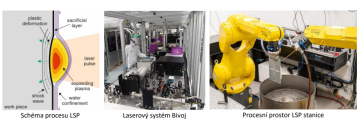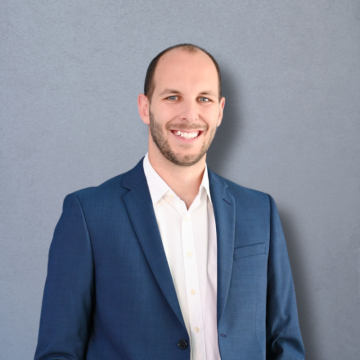Comparison of laser systems in the Laser Shock Peening process
Abstract:
Laser Shock Peening (LSP) is a multidisciplinary process that lies at the intersection of laser physics, plasma physics, and materials engineering. It uses high-energy nanosecond laser pulses to generate compressive residual stresses in metallic materials. These materials then exhibit longer fatigue life and generally higher resistance to cracks of all kinds.
The LSP process uses discharge lamps or diode-pumped nanosecond laser sources that generate a laser beam with a top-hat intensity distribution. The quality and shape of the laser beam (both spatial and temporal) have a major impact on the final quality of the LSP processing.
HiLASE currently has three different laser systems that can be used for the LSP process. These include the state-of-the-art experimental diode-pumped laser system Bivoj, which is capable of generating pulses of up to 100J with an average power of 1 kW. The other two systems are discharge-pumped, one of which is a commercial Litron system with a maximum energy of 3 J, and the other is a semi-commercial Innolas system with an energy of 4 J and a modified laser seed.
The aim of the work is to compare all available laser sources when applying LSP to one selected material. Specific correlations will be sought between the temporal and spatial pulse waveform and the surface and depth profile of the induced residual stresses. Residual stresses will be measured using an X-ray diffractometer and a drill. The plastic deformation of the material surface after the laser pulse impact will be measured on a profilometer. All of the analytical instruments mentioned are located directly in the LSP laboratory.
During the work, students will become thoroughly familiar with LSP technology and will actively participate in sample processing, working with lasers, and subsequent sample analysis.
What do we offer?
- Flexible working hours adapted to your class schedule
- Hands-on experience with advanced laser technologies
- Expert guidance and mentoring from experienced researchers
- Access to a modern laboratory and a friendly team of colleagues
Number of vacancies for this topic: 1
Supervisor: Doc. Ing. Ladislav Pína, DrSc.
Consultant: Ing. Jan Kaufman, Ph.D.
Field: Physics, Applied Research
Type of work: Bachelor’s thesis
Training workplace: HiLASE, Institute of Physics, Czech Academy of Sciences
Language: Czech, English
Location: Dolní Břežany

Join us and step into the fascinating world of lasers!
If you think we could work well together, send me your CV and a few words about why you would like to do an internship with us.
I look forward to hearing from you!
Jan
Please always include the following text with your email/letter so that we can process the information you send us:
I agree that my personal data sent to FZU AV ČR, v.v.i., with its registered office at Na Slovance 2, 182 21 Prague 8, may be used in accordance with Act No. 110/2019 Coll. exclusively for the purposes of job placement and maintaining a database of job applicants. This consent is given for a period of one year and can be revoked in writing at any time.
Contact
